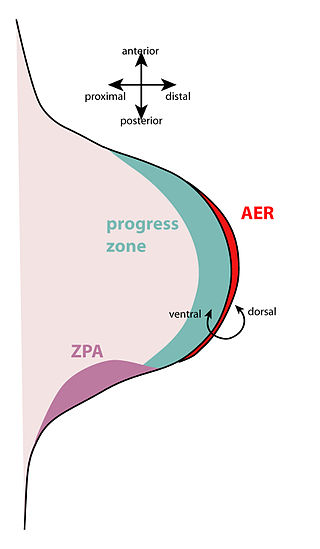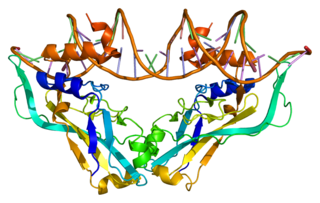Related Research Articles

Sonic hedgehog protein (SHH) is encoded for by the SHH gene. The protein is named after the video game character Sonic the Hedgehog.

In cellular biology, paracrine signaling is a form of cell signaling, a type of cellular communication in which a cell produces a signal to induce changes in nearby cells, altering the behaviour of those cells. Signaling molecules known as paracrine factors diffuse over a relatively short distance, as opposed to cell signaling by endocrine factors, hormones which travel considerably longer distances via the circulatory system; juxtacrine interactions; and autocrine signaling. Cells that produce paracrine factors secrete them into the immediate extracellular environment. Factors then travel to nearby cells in which the gradient of factor received determines the outcome. However, the exact distance that paracrine factors can travel is not certain.
Bone morphogenetic proteins (BMPs) are a group of growth factors also known as cytokines and as metabologens. Originally discovered by their ability to induce the formation of bone and cartilage, BMPs are now considered to constitute a group of pivotal morphogenetic signals, orchestrating tissue architecture throughout the body. The important functioning of BMP signals in physiology is emphasized by the multitude of roles for dysregulated BMP signalling in pathological processes. Cancerous disease often involves misregulation of the BMP signalling system. Absence of BMP signalling is, for instance, an important factor in the progression of colon cancer, and conversely, overactivation of BMP signalling following reflux-induced esophagitis provokes Barrett's esophagus and is thus instrumental in the development of esophageal adenocarcinoma.

Zinc finger protein GLI2 also known as GLI family zinc finger 2 is a protein that in humans is encoded by the GLI2 gene. The protein encoded by this gene is a transcription factor.

Zinc finger protein GLI3 is a protein that in humans is encoded by the GLI3 gene.
The Hedgehog signaling pathway is a signaling pathway that transmits information to embryonic cells required for proper cell differentiation. Different parts of the embryo have different concentrations of hedgehog signaling proteins. The pathway also has roles in the adult. Diseases associated with the malfunction of this pathway include cancer.

Noggin, also known as NOG, is a protein that is involved in the development of many body tissues, including nerve tissue, muscles, and bones. In humans, noggin is encoded by the NOG gene. The amino acid sequence of human noggin is highly homologous to that of rat, mouse, and Xenopus.

Bone morphogenetic protein 4 is a protein that in humans is encoded by BMP4 gene. BMP4 is found on chromosome 14q22-q23.

Bone morphogenetic protein 6 is a protein that in humans is encoded by the BMP6 gene.

Bone morphogenetic protein 3, also known as osteogenin, is a protein in humans that is encoded by the BMP3 gene.

The bone morphogenetic protein receptor, type IA also known as BMPR1A is a protein which in humans is encoded by the BMPR1A gene. BMPR1A has also been designated as CD292.

The apical ectodermal ridge (AER) is a structure that forms from the ectodermal cells at the distal end of each limb bud and acts as a major signaling center to ensure proper development of a limb. After the limb bud induces AER formation, the AER and limb mesenchyme—including the zone of polarizing activity (ZPA)—continue to communicate with each other to direct further limb development.

Limb development in vertebrates is an area of active research in both developmental and evolutionary biology, with much of the latter work focused on the transition from fin to limb.
The limb bud is a structure formed early in vertebrate limb development. As a result of interactions between the ectoderm and underlying mesoderm, formation occurs roughly around the fourth week of development. In the development of the human embryo the upper limb bud appears in the third week and the lower limb bud appears four days later.

Growth differentiation factor 6 (GDF6) is a protein that in humans is encoded by the GDF6 gene.

Cerberus is a protein that in humans is encoded by the CER1 gene. Cerberus is a signaling molecule which contributes to the formation of the head, heart and left-right asymmetry of internal organs. This gene varies slightly from species to species but its overall functions seem to be similar.

Fibroblast growth factor 8(FGF-8) is a protein that in humans is encoded by the FGF8 gene.

T-box transcription factor 2 Tbx2 is a transcription factor that is encoded by the Tbx2 gene on chromosome 17q21-22 in humans. This gene is a member of a phylogenetically conserved family of genes that share a common DNA-binding domain, the T-box. Tbx2 and Tbx3 are the only T-box transcription factors that act as transcriptional repressors rather than transcriptional activators, and are closely related in terms of development and tumorigenesis. This gene plays a significant role in embryonic and fetal development through control of gene expression, and also has implications in various cancers. Tbx2 is associated with numerous signaling pathways, BMP, TGFβ, Wnt, and FGF, which allow for patterning and proliferation during organogenesis in fetal development.

The zone of polarizing activity (ZPA) is an area of mesenchyme that contains signals which instruct the developing limb bud to form along the anterior/posterior axis. Limb bud is undifferentiated mesenchyme enclosed by an ectoderm covering. Eventually, the limb bud develops into bones, tendons, muscles and joints. Limb bud development relies not only on the ZPA, but also many different genes, signals, and a unique region of ectoderm called the apical ectodermal ridge (AER). Research by Saunders and Gasseling in 1948 identified the AER and its subsequent involvement in proximal distal outgrowth. Twenty years later, the same group did transplantation studies in chick limb bud and identified the ZPA. It wasn't until 1993 that Todt and Fallon showed that the AER and ZPA are dependent on each other.
Within molecular and cell biology, temporal feedback, also referred to as interlinked or interlocked feedback, is a biological regulatory motif in which fast and slow positive feedback loops are interlinked to create "all or none" switches. This interlinking produces separate, adjustable activation and de-activation times. This type of feedback is thought to be important in cellular processes in which an "all or none" decision is a necessary response to a specific input. The mitotic trigger, polarization in budding yeast, mammalian calcium signal transduction, EGF receptor signaling, platelet activation, and Xenopus oocyte maturation are examples for interlinked fast and slow multiple positive feedback systems.
References
- 1 2 3 Gazzerro E, Pereira RC, Jorgetti V, Olson S, Economides AN, Canalis E (2005). "Skeletal overexpression of gremlin impairs bone formation and causes osteopenia". Endocrinology. 146 (2): 655–65. doi: 10.1210/en.2004-0766 . PMID 15539560.
- 1 2 Stabile H, Mitola S, Moroni E, Belleri M, Nicoli S, Coltrini D, Peri F, Pessi A, Orsatti L, Talamo F, Castronovo V, Waltregny D, Cotelli F, Ribatti D, Presta M (2007). "Bone morphogenic protein antagonist Drm/gremlin is a novel proangiogenic factor". Blood. 109 (5): 1834–40. doi: 10.1182/blood-2006-06-032276 . hdl: 11379/29323 . PMID 17077323.
- 1 2 Namkoong H, Shin SM, Kim HK, Ha SA, Cho GW, Hur SY, Kim TE, Kim JW (2006). "The bone morphogenetic protein antagonist gremlin 1 is overexpressed in human cancers and interacts with YWHAH protein". BMC Cancer. 6: 74. doi: 10.1186/1471-2407-6-74 . PMC 1459871 . PMID 16545136.
- ↑ Zúñiga A, Haramis AP, McMahon AP, Zeller R (1999). "Signal relay by BMP antagonism controls the SHH/FGF4 feedback loop in vertebrate limb buds". Nature. 401 (6753): 598–602. Bibcode:1999Natur.401..598Z. doi:10.1038/44157. PMID 10524628. S2CID 4372393.
- ↑ Zuniga A, Michos O, Spitz F, Haramis AP, Panman L, Galli A, Vintersten K, Klasen C, Mansfield W, Kuc S, Duboule D, Dono R, Zeller R (2004). "Mouse limb deformity mutations disrupt a global control region within the large regulatory landscape required for Gremlin expression". Genes Dev. 18 (13): 1553–64. doi:10.1101/gad.299904. PMC 443518 . PMID 15198975.
- ↑ Bénazet JD, Bischofberger M, Tiecke E, Gonçalves A, Martin JF, Zuniga A, Naef F, Zeller R (2009). "A self-regulatory system of interlinked signaling feedback loops controls mouse limb patterning". Science. 323 (5917): 1050–3. Bibcode:2009Sci...323.1050B. doi:10.1126/science.1168755. PMID 19229034. S2CID 25309127.
- ↑ Khokha MK, Hsu D, Brunet LJ, Dionne MS, Harland RM (2003). "Gremlin is the BMP antagonist required for maintenance of Shh and Fgf signals during limb patterning". Nat. Genet. 34 (3): 303–7. doi:10.1038/ng1178. PMID 12808456. S2CID 19761724.
- ↑ Michos O, Panman L, Vintersten K, Beier K, Zeller R, Zuniga A (2004). "Gremlin-mediated BMP antagonism induces the epithelial-mesenchymal feedback signaling controlling metanephric kidney and limb organogenesis". Development. 131 (14): 3401–10. doi: 10.1242/dev.01251 . PMID 15201225.
- ↑ Michos O, Gonçalves A, Lopez-Rios J, Tiecke E, Naillat F, Beier K, Galli A, Vainio S, Zeller R (2007). "Reduction of BMP4 activity by gremlin 1 enables ureteric bud outgrowth and GDNF/WNT11 feedback signalling during kidney branching morphogenesis". Development. 134 (13): 2397–405. doi:10.1242/dev.02861. PMID 17522159. S2CID 7867216.
- ↑ Shi W, Zhao J, Anderson KD, Warburton D (2001). "Gremlin negatively modulates BMP-4 induction of embryonic mouse lung branching morphogenesis". Am. J. Physiol. Lung Cell Mol. Physiol. 280 (5): L1030–9. doi:10.1152/ajplung.2001.280.5.L1030. PMID 11290528. S2CID 16350339.
- ↑ Elemam NM, Malek AI, Mahmoud EE, El-Huneidi W, Talaat IM (2022-01-28). "Insights into the Role of Gremlin-1, a Bone Morphogenic Protein Antagonist, in Cancer Initiation and Progression". Biomedicines. 10 (2): 301. doi: 10.3390/biomedicines10020301 . ISSN 2227-9059. PMC 8869528 . PMID 35203511.
- ↑ Li D, Yuan D, Shen H, Mao X, Yuan S, Liu Q (2019-10-21). "Gremlin-1: An endogenous BMP antagonist induces epithelial-mesenchymal transition and interferes with redifferentiation in fetal RPE cells with repeated wounds". Molecular Vision. 25: 625–635. ISSN 1090-0535. PMC 6817737 . PMID 31700227.
- ↑ Sneddon JB, Zhen HH, Montgomery K, van de Rijn M, Tward AD, West R, Gladstone H, Chang HY, Morganroth GS, Oro AE, Brown PO (2006). "Bone morphogenetic protein antagonist gremlin 1 is widely expressed by cancer-associated stromal cells and can promote tumor cell proliferation". Proc. Natl. Acad. Sci. U.S.A. 103 (40): 14842–7. Bibcode:2006PNAS..10314842S. doi: 10.1073/pnas.0606857103 . PMC 1578503 . PMID 17003113.
- 1 2 3 Gazzerro E, Smerdel-Ramoya A, Zanotti S, Stadmeyer L, Durant D, Economides AN, Canalis E (2007). "Conditional deletion of gremlin causes a transient increase in bone formation and bone mass". J. Biol. Chem. 282 (43): 31549–57. doi: 10.1074/jbc.M701317200 . PMID 17785465.
- ↑ Jacqueline L. Norrie, Jordan P. Lewandowski, Cortney M. Bouldin, Smita Amarnath, Qiang Li, Martha S. Vokes, Lauren I.R. Ehrlich, Brian D. Harfe, Steven A. Vokes. Dynamics of BMP signaling in limb bud mesenchyme and polydactyly (2014) Developmental Biology Volume 393, Issue 2, Pages 270–281
- ↑ Li, Q., Lewandowski, J. P., Powell, M. B., Norrie, J. L., Cho, S. H. and Vokes, S. a (2014). A Gli silencer is required for robust repression of gremlin in the vertebrate limb bud. Development 141, 1906–14
- ↑ Zuniga, A., Laurent, F., Lopez-Rios, J., Klasen, C., Matt, N. and Zeller, R. (2012). Conserved cis-regulatory regions in a large genomic landscape control SHH and BMP-regulated Gremlin1 expression in mouse limb buds. BMC Dev. Biol. 12, 23